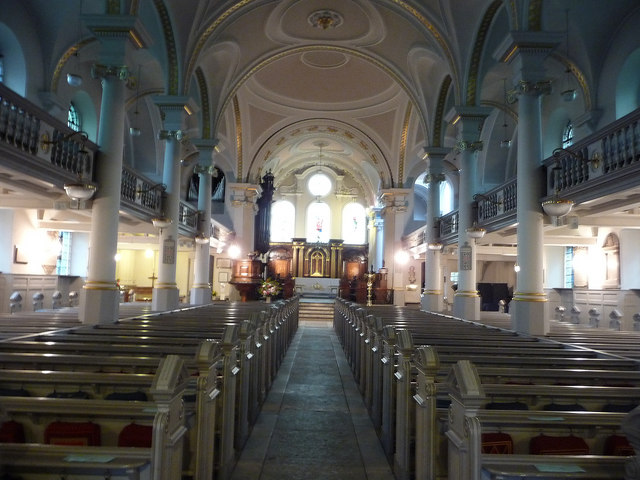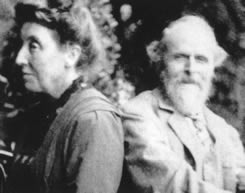|
Constance Phillott
Constance Phillott (1842 – 30 March 1931) was a British painter. Phillott was born in Bloomsbury, London. She was the second daughter of Arthur Phillott (1813-1853), a physician, and Frances Caroline Frend (1811-1912). Her mother, who died aged 102, was the daughter of reformer William Frend. She had an older sister, Mary Agnes (1840-1921), who married John Robert Seeley in 1869, and a younger sister, Edith Frend Phillott (1852-1927). She got her education at the Royal Academy schools, along with her cousin William Frend De Morgan and his later wife, Mary Evelyn Pickering. Phillott exhibited with a number of societies, including the Royal Academy, the Society of British Artists, multiple galleries, such as the Grosvenor Gallery, and she was elected an associate of the Royal Society of Painters in Water Colours. Constance declared her support for female suffrage and joined the London suffrage society in 1889. There is no trace of her exhibiting after the 1880s, and it is unc ... [...More Info...] [...Related Items...] OR: [Wikipedia] [Google] [Baidu] |
United Kingdom
The United Kingdom of Great Britain and Northern Ireland, commonly known as the United Kingdom (UK) or Britain, is a country in Europe, off the north-western coast of the continental mainland. It comprises England, Scotland, Wales and Northern Ireland. The United Kingdom includes the island of Great Britain, the north-eastern part of the island of Ireland, and many smaller islands within the British Isles. Northern Ireland shares a land border with the Republic of Ireland; otherwise, the United Kingdom is surrounded by the Atlantic Ocean, the North Sea, the English Channel, the Celtic Sea and the Irish Sea. The total area of the United Kingdom is , with an estimated 2020 population of more than 67 million people. The United Kingdom has evolved from a series of annexations, unions and separations of constituent countries over several hundred years. The Treaty of Union between the Kingdom of England (which included Wales, annexed in 1542) and the Kingdom of Scotland in 170 ... [...More Info...] [...Related Items...] OR: [Wikipedia] [Google] [Baidu] |
Regent's Park
Regent's Park (officially The Regent's Park) is one of the Royal Parks of London. It occupies of high ground in north-west Inner London, administratively split between the City of Westminster and the Borough of Camden (and historically between Marylebone and Saint Pancras parishes). In addition to its large central parkland and ornamental lake, it contains various structures and organizations both public and private, generally on its periphery, including Regent's University and London Zoo. What is now Regent's Park came into possession of the Crown upon the dissolution of the monasteries in the 1500s, and was used for hunting and tenant farming. In the 1810s, the Prince Regent proposed turning it into a pleasure garden. The park was designed by John Nash and James and Decimus Burton. Its construction was financed privately by James Burton after the Crown Estate rescinded its pledge to do so, and included development on the periphery of townhouses and expensive terrace dw ... [...More Info...] [...Related Items...] OR: [Wikipedia] [Google] [Baidu] |
1931 Deaths
Events January * January 2 – South Dakota native Ernest Lawrence invents the cyclotron, used to accelerate particles to study nuclear physics. * January 4 – German pilot Elly Beinhorn begins her flight to Africa. * January 22 – Sir Isaac Isaacs is sworn in as the first Australian-born Governor-General of Australia. * January 25 – Mohandas Gandhi is again released from imprisonment in India. * January 27 – Pierre Laval forms a government in France. February * February 4 – Soviet leader Joseph Stalin gives a speech calling for rapid industrialization, arguing that only strong industrialized countries will win wars, while "weak" nations are "beaten". Stalin states: "We are fifty or a hundred years behind the advanced countries. We must make good this distance in ten years. Either we do it, or they will crush us." The first five-year plan in the Soviet Union is intensified, for the industrialization and collectivization of agriculture. * February 10 – O ... [...More Info...] [...Related Items...] OR: [Wikipedia] [Google] [Baidu] |
1842 Births
__NOTOC__ Year 184 ( CLXXXIV) was a leap year starting on Wednesday (link will display the full calendar) of the Julian calendar. At the time, it was known as the Year of the Consulship of Eggius and Aelianus (or, less frequently, year 937 ''Ab urbe condita''). The denomination 184 for this year has been used since the early medieval period, when the Anno Domini calendar era became the prevalent method in Europe for naming years. Events By place China * The Yellow Turban Rebellion and Liang Province Rebellion break out in China. * The Disasters of the Partisan Prohibitions ends. * Zhang Jue leads the peasant revolt against Emperor Ling of Han of the Eastern Han Dynasty. Heading for the capital of Luoyang, his massive and undisciplined army (360,000 men), burns and destroys government offices and outposts. * June – Ling of Han places his brother-in-law, He Jin, in command of the imperial army and sends them to attack the Yellow Turban rebels. * Winter – Zha ... [...More Info...] [...Related Items...] OR: [Wikipedia] [Google] [Baidu] |
St John-at-Hampstead
St John-at-Hampstead is a Church of England parish church dedicated to St John the Evangelist (though the original dedication was only refined from St John to this in 1917 by the Bishop of London) in Church Row, Hampstead, London. History Hampstead was granted to the Benedictine monks of Westminster Abbey by charter in 986. It is likely that they placed a church there soon afterwards, but the first records of one come from 1312 (when it was recorded that John de Neuport was its priest) and 1333 (through a mention of a Chapel dedicated to the Blessed Virgin Mary). On the Dissolution of the Monasteries, the Abbey was replaced by the Bishop of Westminster, with its first and only holder Thomas Thirlby also serving as St John's rector. Thirlby appointed Thomas Chapelyne to be St John's vicar in 1545, but the see was abolished in 1551 by Edward VI, with the manor and benefice of Hampstead being granted to Sir Thomas Wrothe. The church of this era was part in stone and part in tim ... [...More Info...] [...Related Items...] OR: [Wikipedia] [Google] [Baidu] |
Downshire Hill
Downshire Hill is a street in Hampstead, London, in the London Borough of Camden. The street has always been a preferred residential address, in which the artist Dante Gabriel Rossetti and the actress Peggy Ashcroft as well as the scientist J. D. Bernal and Peter Medawar resided. Geography The road runs between the A 502 (Rosslyn Hill) in the southwest and East Heath Road / South End Road in the northeast. The only branches are Keats Grove and Willow Road. While the road ends in the northeast on the edge of the Hampstead Heath nature park, it is "continued" in a south-westerly direction by Thurlow Road. On the grounds between Downshire Hill and Keats Grove is the St John's Downshire Hill. History The road was laid out at the beginning of the 19th century and is probably named after the first Marquess of Downshire, Wills Hill (1718–1793). Known residents During the First World War, the literary figures Constance, Edward and David Garnett lived in house number 6. In th ... [...More Info...] [...Related Items...] OR: [Wikipedia] [Google] [Baidu] |
Women Painters Of The World
''Women Painters of the World, from the time of Caterina Vigri, 1413–1463, to Rosa Bonheur and the present day'', assembled and edited by Walter Shaw Sparrow, lists an overview of prominent women painters up to 1905, the year of publication. The purpose of the book was to prove wrong the statement that "the achievements of women painters have been second-rate." The book includes well over 300 images of paintings by over 200 painters, most of whom were born in the 19th century and won medals at various international exhibitions. The book is a useful reference work for anyone studying women's art of the late 19th century. List of women in the book *Louise Abbéma * Madame Abran ( Marthe Abran, 1866-1908) *Georges Achille-Fould *Helen Allingham * Anna Alma-Tadema *Laura Theresa Alma-Tadema *Sophie Gengembre Anderson *Helen Cordelia Angell *Sofonisba Anguissola * Christine Angus *Berthe Art *Gerardina Jacoba van de Sande Bakhuyzen * Antonia de Bañuelos * Rose Maynard Barton *Marie ... [...More Info...] [...Related Items...] OR: [Wikipedia] [Google] [Baidu] |
Royal Society Of Painters In Water Colours
The Royal Watercolour Society is a British institution of painters working in watercolours. The Society is a centre of excellence for water-based media on paper, which allows for a diverse and interesting range of approaches to the medium of watercolour. Its members, or associates, use the postnominal initials RWS. They are elected by the membership, with typically half a dozen new associates joining the Society each year. History The society was founded as the ''Society of Painters in Water Colours'' in 1804 by William Frederick Wells. Its original membership was William Sawrey Gilpin, Robert Hills, John Claude Nattes, John Varley, Cornelius Varley, Francis Nicholson, Samuel Shelley, William Henry Pyne and Nicholas Pocock. The members seceded from the Royal Academy where they felt that their work commanded insufficient respect and attention. In 1812, the Society reformed as the ''Society of Painters in Oil and Watercolours'', reverting to its original name in 1820. In 18 ... [...More Info...] [...Related Items...] OR: [Wikipedia] [Google] [Baidu] |
Grosvenor Gallery
The Grosvenor Gallery was an art gallery in London founded in 1877 by Sir Coutts Lindsay and his wife Blanche. Its first directors were J. Comyns Carr and Charles Hallé. The gallery proved crucial to the Aesthetic Movement because it provided a home for those artists whose approaches the more classical and conservative Royal Academy did not welcome, such as Edward Burne-Jones and Walter Crane. History The gallery was founded in Bond Street, London, in 1877 by Sir Coutts Lindsay and his wife Blanche. They engaged J. Comyns Carr and Charles Hallé as co-directors. Lindsay and his wife were well-born and well-connected, and both were amateur artists. Blanche was born a Rothschild, and it was her money which made the whole enterprise possible. The Grosvenor displayed work by artists from outside the British mainstream, including Edward Burne-Jones, Walter Crane and other members of the Pre-Raphaelite Brotherhood. But it also featured work by others that were widely shown elsew ... [...More Info...] [...Related Items...] OR: [Wikipedia] [Google] [Baidu] |
Mary Evelyn Pickering
Evelyn De Morgan (30 August 1855 – 2 May 1919), née Pickering, was an English painter associated early in her career with the later phase of the Pre-Raphaelite Movement, and working in a range of styles including Aestheticism and Symbolism. Her paintings are figural, foregrounding the female body through the use of spiritual, mythological, and allegorical themes. They rely on a range of metaphors (such as light and darkness, transformation, and bondage) to express what several scholars have identified as spiritualist and feminist content. De Morgan boycotted the Royal Academy and signed the Declaration in Favour of Women's Suffrage in 1889. Her later works also deal with the themes of war from a pacifist perspective, engaging with conflicts like the Second Boer War and World War I. Early life She was born Mary Evelyn Pickering at 6 Grosvenor Street, to Percival Pickering QC, the Recorder of Pontefract, and Anna Maria Wilhelmina Spencer Stanhope, the sister of the art ... [...More Info...] [...Related Items...] OR: [Wikipedia] [Google] [Baidu] |





